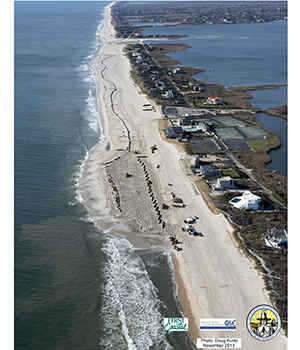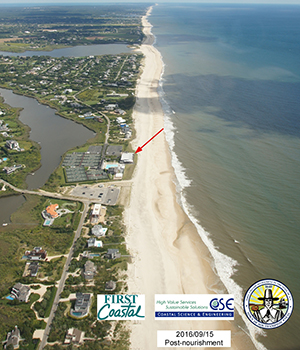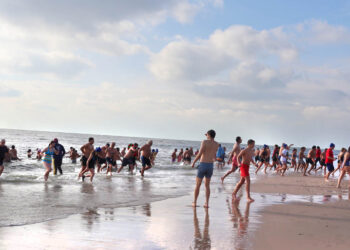The American Shore and Beach Preservation Association (ASBPA) founded in 1926 advocates for healthy coastlines by promoting the integration of science, policies and actions that maintain, protect and enhance the coasts of America.
ASBPA recently released its annual list of the “the nation’s best restored beaches” for beaches from the north Atlantic, mid-Atlantic, south Atlantic, Pacific and Gulf coasts. Included in this year’s recognition are the beaches in Sagaponack-Bridgehampton. Other beaches around the country that were recognized include Dare County Beaches, NC; Galveston Seawall Beach, TX; Cardiff Beach, Encinitas, CA; and Thompsons Beach, NJ.
Speaking with Kate Gooderham, Managing Director of ASBPA, “One of the things that is quite interesting is that beaches have been restored for a long time, however, back in the 1970’s we kept hearing statements that people did not support beach restoration, and we realized that the average American had no idea just how many of the beaches frequented by citizens around the county have, in fact, been restored. Since most Americans cite beach erosion as one of their main concerns when visiting our beaches around the country, it seemed important to inform people just how much preservation and restoration has been on-going for decades.”
 |
|
Sagaponack-Bridgehampton beach during nourishment in 2013. (Photo: Courtesy of First Coastal) |
Further, according to Gooderham, “ASBPA began in 1926, and in fact the first beach restoration was done in 1927, at Jones Beach in New York. We felt we needed to increase the public’s awareness because statistically American beaches are our largest national park, they are a tremendous natural resource, and are visited by more Americans than visit all national parks – owing in part to the fact that half of the country lies near coastal counties.”
“Since the average citizen was not aware of the tremendous efforts that have been on-going for decades to restore beaches, we felt the use of social media and other outlets by creating the annual ‘Best Restored Beach’ award would keep people informed, and would draw more attention to exactly what our organization does,” relayed Gooderham, “since ASBPA membership tends to include mostly scientists, engineers and beach managers.”
According to ASBPA President Tony Pratt, “The summer of 2018 is upon us and people across the nation are dreaming of sun, surf and sand. Their time at the beach is very often the happiest times of their lives. We here at ASBPA take that love of the coast very seriously. We honor the efforts that go into managing and, when necessary, rebuilding the beaches that are in the hearts of so many vacationers. For more than 50 years, beach restoration has been the preferred method of shore protection in coastal communities. Beach restoration is the process of placing beach-quality sand on dwindling beaches to reverse or offset the effects of erosion.”
Commenting on this year’s recognition, Town of Southampton Supervisor Jay Schneiderman expressed, “The property owners within the erosion control districts deserve the most credit for achieving this distinction; they taxed themselves to re-nourish the ocean beaches that we all enjoy.”
 |
|
Sagaponack-Bridgehampton beach post nourishment in 2016. (Photo: Courtesy of First Coastal) |
The process to enter the Best Restored Beach competition consists of coastal communities nominating their projects for consideration, whereby an independent panel of coastal managers and scientists select the winners. Judging was based on three criteria: (1) the economic and ecological benefits the beach brings to its community; (2) the short- and long-term success of the restoration project; and (3) the challenges each community overcame during the course of the project.
According to Lee Weishar, Ph.D., chair of the Best Restored Beach Committee responsible for making the selections, “I look for commitment and dedication to the project. I want the applicant to make me love his or her beach.”
On our local level, kudos and thanks for his efforts in achieving this award must be extended to Coastal Geologist Aram Terchunian of First Coastal. This company has been involved in natural system restoration for 35 years. Terchunian advised, “The key to all of this is that we are designing with nature, we are replicating the natural beach as closely as we possibly can, and the amount of detail and scientific and engineering design that goes into this is remarkable and that is because the objective is to have someone walk out on the beach and not be able to tell that is restored – and that is the pinnacle of what we were and are trying to achieve.”
The ASPCA web site notes, “This year’s winners spotlight a diverse selection of beaches and challenges, ranging from protecting coastal marshes in a wildlife refuge to protecting upland properties in one of America’s most exclusive locales. What they all have in common, however, is working creatively to address complex coastal issues in a way that is sustainable and mitigate the ravages of nature, compatible with the surrounding environment and achievable in the face of both political and natural obstacles.”
“Sagaponack-Bridgehampton Beach Project was selected because it demonstrated the importance of private and public partnerships which showed that not all beach nourishment projects need to depend on the federal government for funding. Additionally, the project demonstrated that wider beaches and higher dunes increases shoreline resiliency and increases flood protection. This project also shows that restored beaches enhanced vital habitat for the endangered piping plover and threatened least tern, and significantly increases recreation beach areas for the Hamptons. The committee especially like this project because the wider dry sand beach has resulted in natural dune accretion rates averaging nearly 4 cubic yards per foot per year during the first four years after nourishment. The combination of increased width and elevation of the beach/dune system has increased resiliency of the coast during numerous winter storm events since project completion.”
So when you are enjoying the sun, sand, water and waves this summer, look around and appreciate the efforts that have been made to keep our beaches beautiful.
For more information and to get an idea of just how many New York beaches have been restored, go to asbpa.org and click on National Beach Nourishment Database on the right hand side of your screen. Winners will be honored during ASBPA’s annual Coastal Summit held in Washington, DC, in spring 2019.












